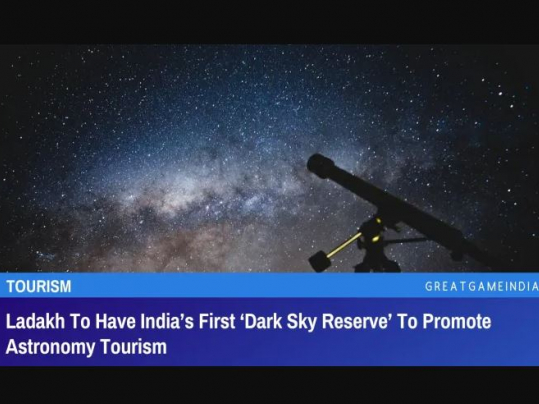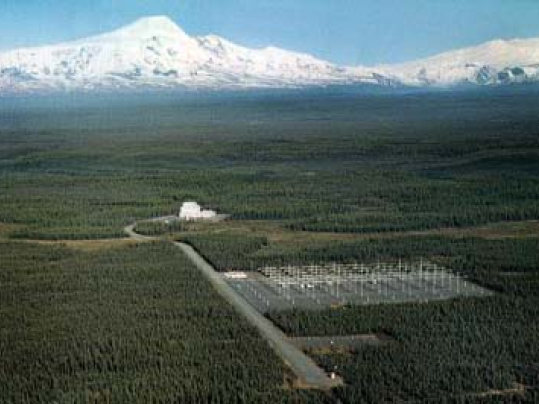Ladakh To Have India’s First ‘Dark Sky Reserve’ To Promote Astronomy Tourism

The Ladakh Union Territory administration is establishing India’s first ‘Dark Sky Reserve’ in Ladakh to promote astronomy tourism with the Changthang Wildlife Sanctuary housing the Hanle Dark Sky Reserve.
India will create its first Dark Sky Reserve by the end of 2022 in the chilly deserts of Ladakh, according to Dr. Jitendra Singh, Minister of State (Independent charge) for Science and Technology, who made the announcement on Saturday. According to him, this facility will also advance astronomy tourism.
What is a Dark Sky Reserve?
A Dark Sky Reserve is a piece of public or private land that has been thoughtfully created to reduce light pollution and has a distinctive nocturnal environment with starry nights.
These reserves “consist of a core area meeting minimum criteria for sky quality and natural darkness, and a peripheral area that supports dark sky preservation in the core,” according to the International Dark Sky Association (IDSA) website.
According to the report, these reserves were created by a “partnership of multiple land managers who have recognized the value of the natural nighttime environment through regulations and long-term planning.”
How does a site become a ‘Dark Sky Reserve’?
Sites can be proposed by individuals or organisations to the International Dark Sky Association (IDSA) for certification. International Dark Sky parks, communities, reserves, sanctuaries, and Urban Night Sky Places are the five designated categories.
The certification procedure is comparable to having a location designated as a Biosphere Reserve or a World Heritage Site by UNESCO. According to the IDSA, 195 locations were recognised as International Dark Sky Places globally between 2001 and January 2022.
The IDSA only considers a piece of land to be a suitable dark sky place if it is either publicly or privately owned, is accessible to the public year-round, is legally protected for scientific, natural, educational, cultural, heritage, and/or public enjoyment purposes, and has the following characteristics: the core area of the land offers an exceptional dark sky resource in comparison to the nearby communities and cities. Additionally, the land must provide a specified level of night sky brightness.
The process of submitting India’s IDSA nomination is currently ongoing.
Who is developing India’s first Dark Sky Reserve?
The first Dark Sky Reserve for the nation is being established under the direction of the Ladakh Union Territory administration.
The Changthang Wildlife Sanctuary will house the Hanle Dark Sky Reserve (HDSR), which will rise to a height of 4,500 metres above sea level.
The development of this ground-breaking facility is receiving scientific and technological assistance from the Department of Science and Technology and specialists from the Indian Institute of Astrophysics (IIA), Bengaluru. The Indian Astronomical Observatory (IAO) facility in Hanle, Ladakh, is already under the IIA’s management.
Here, astronomers have been studying exoplanets, galaxies, and stars via the clear Hanle sky using the gamma-ray, infrared, and optical telescopes that are already in place.
A Memorandum of Understanding (MoU), signed in June of this year by representatives of the Ladakh UT, the IIA, Bengaluru, and the Ladakh Autonomous Hill Development Council, formalised the intention to establish this Dark Sky Reserve.
Why was Ladakh chosen for the project?
About 3,000 metres above sea level, Ladakh is an unique cold desert with high mountainous terrains. Large portions of the UT are nearly uninhabitable due to the long, severe winters and minimum temperatures that fall below minus 40 degrees Celsius.
This region is ideal for long-term astronomical observatories and black sky locations due to its aridity, low vegetation, high elevation, and significant stretches of sparse population.
However, the proposed Dark Sky Reserve’s main goal is to advance astronomy tourism in an environmentally responsible and sustainable way. Scientific methods will be used here to preserve the night sky from ever-increasing light pollution.
There are fewer places that provide a glimpse of pure skies on cloudless nights as metros, cities, and peripheral areas experience light pollution and are constantly lighted up, scientists have noted.
Will this help boost tourism in Ladakh?
Ladakh has experienced an increase in tourism during favourable months since it became a UT. However, its delicate habitat is exposed to increasing carbon emissions and incoming traffic. The importance of making efforts to expand the usage of green fuels and promote carbon-neutral activities was highlighted in the Ladakh Tourism Vision Document 2022.
“The locals in Ladakh are sensitive towards the conservation of the ecosystem. They are keen to protect the environment from getting deteriorated,” according to Prof. Annapurni Subramaniam, Director of the IIA. Experts have been actively interacting with the people since June. Before the HDSR is made available to the public, several projects are in progress.
“Our teams travelled to remote villages to give hand-outs to villagers sharing details about the training programmes,” the IIA Director said.
The IIA has purchased 10 lightweight, portable telescopes and light-reflecting shields for the trial phase. Locals will be identified and instructed in the usage of these telescopes by outreach specialists and scientists from IIA. This will contain fundamental astronomical observations, constellation recognition, and finding the pole star, among other things. These telescopes will be set up in homestays, a popular type of lodging for tourists in Ladakh.
Outdoor lighting will be restricted within a 22 km radius of the Hanle observatory, which will be the central location of the Dark Sky Reserve. High-beam headlights will not be allowed to be used by any vehicles. Homes in this area will be urged to use darker-colored curtains, put up light-reflecting barriers, and turn off all unnecessary lighting.
- Source : GreatGameIndia


















